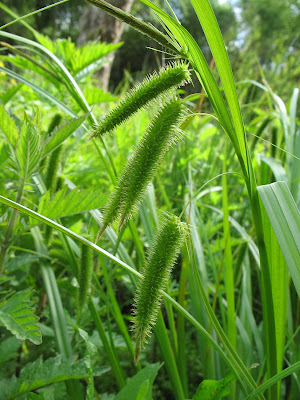Opening the Tern hide a turnstone caught my eye on one of the islands, as I watched it a flock of 6 dunlin flew round. A further search of the shore revealed a seventh dunlin and a single ringed plover. Perhaps dropping in during the overnight rain, unfortunately the rain was not over and we had several heavy showers during the day, often accompanied by very gusty winds, which were not popular with the lapwing or their chicks.
 Later in the morning I visited the Goosander hide for the first time in a while and there was a lot of sand martin activity at the nest holes.
Later in the morning I visited the Goosander hide for the first time in a while and there was a lot of sand martin activity at the nest holes. As the day went on the showers ceased, the cloud broke somewhat and the sun came out, tempting lots of insects out to warm themselves. Along with all the damselflies I spotted a fine black hoverfly with a blood-red band across the abdomen basking on bramble, I had a good view through the binoculars but failed to get a picture. It was Brachypalpoides lentus this species used to be regarded as very rare, although now usually seen as scarce, this is the first record for the reserve and the first that I have ever seen. I also found a clump of cyperus sedge near Ivy Lake, a plant I don't remember seeing on the reserve before.
As the day went on the showers ceased, the cloud broke somewhat and the sun came out, tempting lots of insects out to warm themselves. Along with all the damselflies I spotted a fine black hoverfly with a blood-red band across the abdomen basking on bramble, I had a good view through the binoculars but failed to get a picture. It was Brachypalpoides lentus this species used to be regarded as very rare, although now usually seen as scarce, this is the first record for the reserve and the first that I have ever seen. I also found a clump of cyperus sedge near Ivy Lake, a plant I don't remember seeing on the reserve before. I am trying to add a few more species records for the reserve this summer, as a warm up I did a small scale "BioBlitz" of my own in my garden yesterday morning, 207 species of more or less wildlife, in that I did not include obvious garden plants. Nothing as good as the hoverfly seen today, but I did find box bug, a species that also used to be regarded as very rare but which has now spread. These changes show that things in the natural world do not stand still, as though to illustrate this I recorded only 28 bird species from my garden but these included Mediterranean gull and firecrest, even ten years ago both would have been garden "megas", now a house sparrow would be much more notable than either. I wonder how many species we could find on a Blashford BioBlitz?
I am trying to add a few more species records for the reserve this summer, as a warm up I did a small scale "BioBlitz" of my own in my garden yesterday morning, 207 species of more or less wildlife, in that I did not include obvious garden plants. Nothing as good as the hoverfly seen today, but I did find box bug, a species that also used to be regarded as very rare but which has now spread. These changes show that things in the natural world do not stand still, as though to illustrate this I recorded only 28 bird species from my garden but these included Mediterranean gull and firecrest, even ten years ago both would have been garden "megas", now a house sparrow would be much more notable than either. I wonder how many species we could find on a Blashford BioBlitz?Today the only dragonfly I saw was scarce chaser, another formerly rare species now spreading rapidly, this one looking fine on a yellow flag flower. Of course we don't know how many of these changes are being spurred on by our changing climate and how many are just part of natural ebb and flow of species abundance and range. It does seem clear that climate is changing unusually rapidly and that a lot of species do seem to be changing their status. This means that species once rare become more common, but also that the once common may become rare. A good case for surveying just what is out there now so we can see how things change and what we might do about it.
 I also found a very striking shieldbug nymph, I not sure what species it is, but it looked
I also found a very striking shieldbug nymph, I not sure what species it is, but it looked
 I also found a very striking shieldbug nymph, I not sure what species it is, but it looked
I also found a very striking shieldbug nymph, I not sure what species it is, but it looked 

Hi Robert, I think your splendid shield bug might be Troilus luridus - I came across a photo of one when I was trying to name some of my own insect photos. Lovely dragonfly by the way.
ReplyDeleteLorraine
I think you are right, I have previously seen adults on site. Incidentally britishbugs.org.uk is a great resource for identifying these.
ReplyDeleteBob